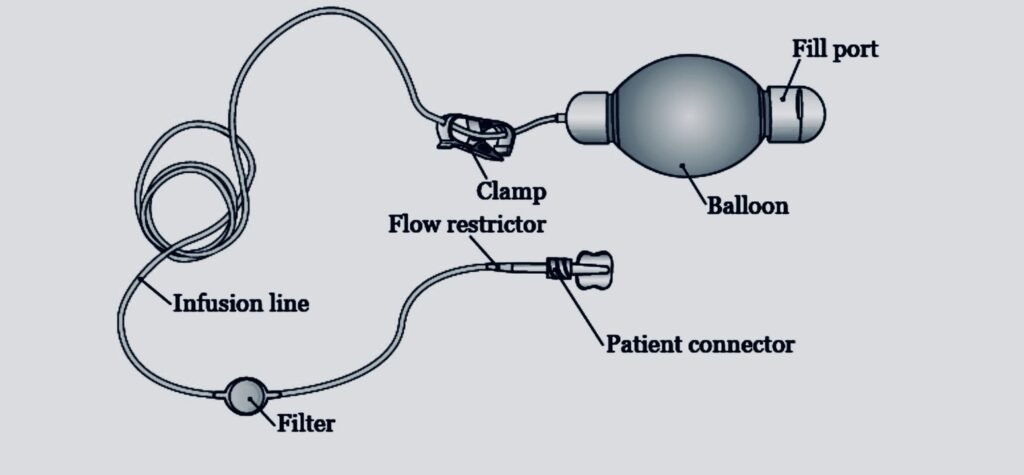Elastomeric pumps are innovative devices used for the controlled infusion of fluids and medications. Unlike electronic pumps, elastomeric pumps rely on the physical properties of an elastic chamber or balloon to regulate the flow of substances into a patient’s body. This article explores the intricacies of elastomeric pumps, their applications, advantages, and disadvantages.
How Elastomeric Pumps Work
Elastomeric pumps feature an elastic chamber or balloon that can stretch to store energy and pressure (typically 260 to 520 mmHg). As this chamber is filled with the desired fluid or medication, it stretches, accumulating pressure. Subsequently, the balloon returns to its original form, expelling the liquid through tubing. To control the flow rate, a flow controller is employed, similar to adjusting resistance on a manual flow regulator.

Table 1: Components of an Elastomeric Pump
| Component | Description |
|---|---|
| Elastic Chamber/Balloon | Stores energy and pressure for controlled flow. |
| Hard Outer Shell | Protects the balloon and maintains its shape. |
| Filling Port | Allows for easy refilling of the pump. |
| Delivery Tube | Carries the infused fluid to the patient. |
| Flow Controller | Regulates and adjusts the flow rate as needed. |
Applications of Elastomeric Pumps
Elastomeric pumps were initially designed to facilitate ambulatory infusion therapies, such as chemotherapy and postoperative analgesia. They have found extensive use in various medical scenarios, including continuous peripheral nerve blockade and the administration of IV analgesic agents like methadone, tramadol, dexketoprofen, and ondansetron.
Advantages and Disadvantages
Advantages of Elastomeric Pumps
- User-Friendly: Elastomeric pumps are known for their simplicity. They involve fewer setup errors and technical complications compared to other infusion devices.
- No Need for Batteries: Unlike electronic pumps, elastomeric pumps do not rely on batteries or electrical power sources, making them highly reliable.
- Portability: These pumps are suitable for ambulatory patients, allowing for the delivery of postoperative analgesia at home immediately after surgery.
- Reusable: Elastomeric pumps are single-use disposable devices that can be refilled multiple times before disposal, maintaining a consistent delivery rate and performance.
- Long Infusion Duration: These pumps can provide infusions lasting several hours up to seven days.
- Overall Safety: Studies have shown that the use of elastomeric pumps for home-based analgesic administration results in minimal device-related adverse effects or catheter-related complications.
Disadvantages of Elastomeric Pumps
- Accuracy and Consistency: Elastomeric pumps may exhibit poor accuracy and consistency in delivering the set flow rate, with variations of up to ±15 percent. Several factors contribute to these inconsistencies, including the filling volume, catheter gauge, and pump positioning.
- Lack of Alarms: Unlike electronic pumps, elastomeric pumps lack alarms to alert users of potential issues.
- Drug Degradation: Some medications, particularly antibiotics, may degrade within the elastomeric chamber, necessitating careful consideration and monitoring.
In conclusion, elastomeric pumps offer a convenient and portable solution for ambulatory infusion therapies. While they come with certain limitations, their ease of use and reliability make them a valuable tool in healthcare settings.


